Best of Reaktor User Library march 2.014
Effects
Base Echo RE-012
by ZooTook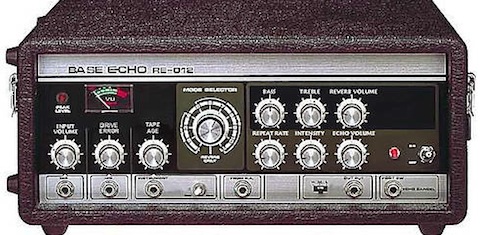
Space Echo RE-201 emulation
This is a copy/paste from the MiniMojo ensemble (also found in the UL). This is not a proper stereo effect but uses only mono input (left channel) followed by mono processing and then output to both left and right output (mono in and stereo out). Driving the input level hard will saturate the pre-amp. Don't forget the bypass switch which can be used in combination with wild self oscillation when Intensity is set high
***
Samplers
Cornelia monoliner autobass 1.6
by Bernd Keil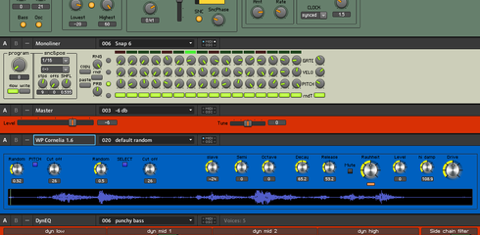
more random than pata
using serveral macros from NI Reaktor 5 user library
***
Hammer & Nails
by Charles Capsis IV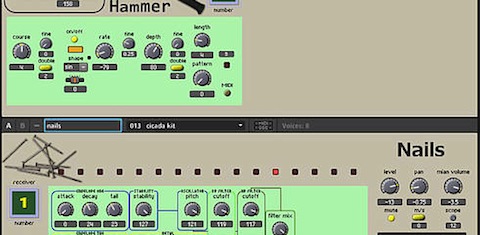
Hammer pounds Nails
An experimental rhythm machine: useful to create pops, clicks, bells, & percussive type sounds.
***
World pataPhys Nails
by Bernd Keil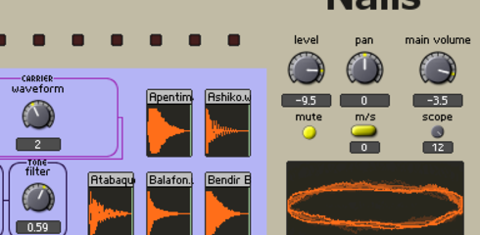
sample mod of Hammer & Nails
gate pattern generator & percussive sound module
mod: add world percussion samples
add unvisible pataphysical macros
max contain: 296 different samples
samples from drmBrst.map
***
Sequencers
Step Seq v4.5r
by michael lancaster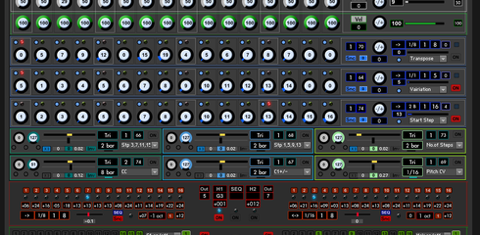
****Requires Reaktor v5.9******
V4
I've added Scaler,harmonizer,tie s, switch seqs and finally managed to make a snapseq that works how i wanted.i've also done a read me explaining whats what.There are still areas that haven't been able to tamed and may result in the odd stuck note.
any problems please report.
As always experiment and enjoy
mike
V4.1r
fixes a problem when used as aplug in ,missing step 1,but i think i've fixed it
V4.2r
Tamed the VR's,so they don't give stuck notes and stop at next on step.
V4.3r
Fixed a few things.less stuck notes.
+midi thru and new groover control and step jump variation
**D/L fixed** and authorising problem sorted…oopps
V4.4r
Fixed a few more things+key monitor
V4.5r
Expanded midi thru and got rid of stuck notes when changing channels.
Added modulation to lfo's
V4.5.1
Fixed a bug in lfo modulation(kept resetting)
The odd tweak
***
WPP 1.3
by Bernd Keil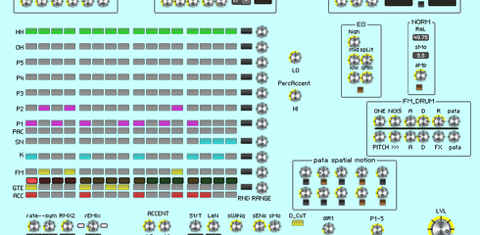
World PercPannax
Pannax based on LIME.lite DrumPartner
and on Martin Brinkmann's Prescool
feat. by Uwe G.
Hoenig's Seq Remix Part and Lazyfish's Env Follower, built by REMMER 9/2003
your funky drummer
added pataPhys and five tracks with world perc samples
2008 - 2014 Reaktor 5.9
***
Snapshots
210110
by Bernd Keil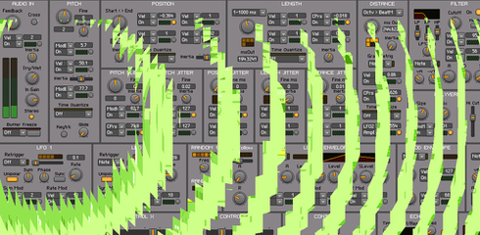
23 LIVE ssf for GRIP 1.1
***
Synthesizers
MiniMojo
by ZooTook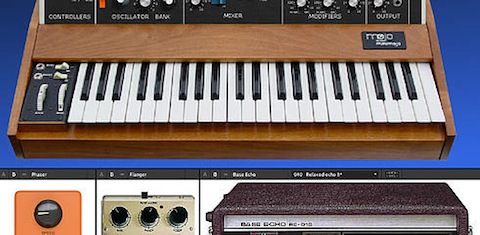
Ensemble with Minimoog, Space Echo RE-201, Electric Mistress
When asking synth aficionados about their favorite synths they describe them as having a specific raw power and organic feel. Minimoog, Jupiter 4, SEM, OBX, Odyssey, Roland System 100, Moog Modular III, CS80 comes in high but also Polymoog, Prophet 5 and Polivocs are held high and described as organic and raw. Note that most but not all* on the list of favorite synths are first or second generation of synth with design made in the 70s. The reason to the raw power and organic feel is in my opinion the basic (or even poor) design and fairly low quality components (compared to today). It's important to understand that there are many factors behind that organic and raw sound and it's not equal to distortion. Overdriving the filter gives a lot of character, specifically at higher resonance values, but it's not the only factor. Just by adding some white noise is also not way to analog nirvana. Zero delay filters are much acclaimed recent years and offering the correct frequency response is important but it is still not a one way ticket to vintage weirdness.
People have tried to imitate analog synthesizers for decades e.g. by sample a single wav cycle but failed badly. Not only should waveforms be non perfect from a mathematical point of view they should also vary over time, just like a violin. However it's not the detuning and the drift, which is mainly a nuance and could easily be emulated by detuning the oscillators on purpose but instead, it's the microscopic variation in all parts of the circuitry that makes all aspect of the sound to continuously varying over time. These variations are very flattering to the brain as humans are very good at pattern recognition. Hearing a static sound becomes dull quite quickly but subtle or even subliminal changes becomes interesting and pleasing to listen to.
E.g the oscillators might vary in frequency and amplitude at high frequency adding more of a noise character but also variations at frequencies above and below the played note. Same with the frequency of the filter and the amplitude response of the amplifier; all functions varying at all frequencies.
Analog Legacy is the theory of modulating all functions in a synthesizer at all frequencies. The key is to find the right balance of the modulation depth for each frequency. Minimojo is the first attempt to use this theory in practice.
Just to make it clear: The Minimojo is not in any way a copy of MONARK. I have not used or have had access to MONARK during the making of Minimojo. Instead the old ensemble Minimood made by NI in 1999, which has then been modified by several users, has been used as the starting point. I think that the basic structure will be recognizable from that early ensemble.
*Polivoks might not be designed in the 70 but the point is that the design and components are not of high quality measured by todays standard
***
modal 32 .1
by ward de jager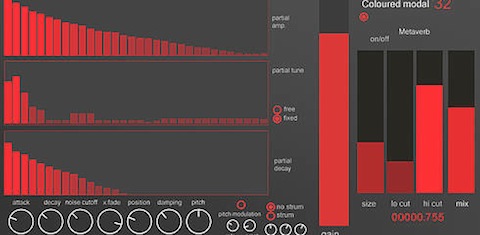
32 partial modal instr.
Well basicaly it's the modul bank tutorial ..+some extras,..mouse sweeping for instant editing of the first 32 partials ...tuning , amplitude and decay ..
Fixed and user defined harmonic series
Added the metaver from stephan schmidt ensemble ca-osc' ( try it , it's wonderfull )
***
Skywarp
by Donald Philips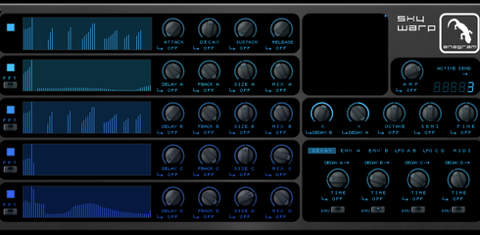
Morphing Additive Synthesizer
Skywarp is an polyphonic additive synthesizer that can morph between sounds. There are 4 slots – each one contains data to control a sine bank, which can either be drawn by hand or taken from incoming audio. Morphing between the sounds can be controlled by hand using an XY module (similar to the one in FM8), via MIDI, or by using the built in modulation network.
Video tutorial available here: http://www.youtube.com/watch?v=BK2gaeR4N54
Skywarp requires REAKTOR 5.6.2 or later.
***
ugh GRIP 1.1
by Uwe G.Hoenig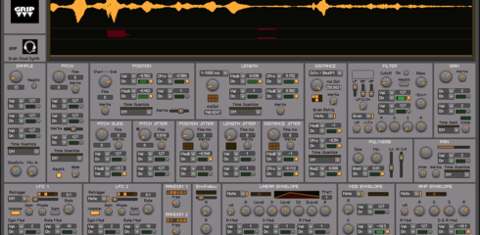
Polyphonic Grain Cloud Synth – between tonal and rhythmic...
Version 1.1 – see bottom of page for version history
-------------------------------------------------------
GRIP polyphonic grain cloud synth for NI Reaktor
Uwe G. Hoenig, 2012-2014
Videos
- Some presets (same sounds as above):
https://www.youtube.com/watch?v=r2SRr4raXhM
- A live demo:
https://www.youtube.com/watch?v=5IvVz3q94KY
Help and contact
See the "B" panel of GRIP or here for a quick guide:
https://dl.dropboxusercontent.com/u/69695064/GRIP_Help.png
To contact me please use the comments in the Reaktor user library.
GRIP
• is an instrument between sampler and synth
• is based on Reaktor's Grain Cloud module
• is a late successor to my "Travelizer" from the NI library
• offers a nice set of samples and presets
• can be played polyphonically from a MIDI keyboard or other controllers
• produces a great variety of sounds, depending on the samples and settings
• offers extensive and some rather unique modulation possibilities
• can also be used with live audio input
Some tech specs
• granular synthesis based on pre-loaded samples or live input
• up to 30 simultaneous grains per voice
• granular parameters include pitch, pitch slide, position, legth, distance, gain, envelope and various jitter parameters
• can use stereo samples or stereo live audio in, signal path is stereo throughout
• LP/BP/HP filter
• two LFOs, polyphonic
• four envelope generators, polyphonic
• one envelope follower, polyphonic
• two random generators, polyphonic
• a reverb (taken from "Prism"), polyphonic (yes!) and with modulatable reverb time
• a simple delay effect with feedback
• the panel includes many LEDs for visualizing the modulations, this layout is made for six-voice polyphony
Requirements
• Reaktor 5.9.0 or newer
• GRIP can be quite CPU-intensive; reduce the instrumet's voices if you encounter crackles etc.
• a current-generation i5/i7 cpu is recommended for 6-voice polyphony (GRIP's default)
-------------------------------------------------------
To play GRIP
- use GRIP as a plugin instance or stand-alone, both work fine
- start the clock in Reaktor stand alone / the playback of your DAW (as GRIP uses the clock for various modulations)
- select the GRIP instrument, choose a preset band and a preset
- feed it some MIDI note, modwheel and aftertouch data
To go a little deeper
- try the BIG knobs first when tweaking presets
- try choosing other samples for a given preset (with the big Sample knob under the ugh logo) – and load your own samples
- right click on the white label bar above the sample display to access the sample map and to load samples
- activate Reaktor's info function to get some mouseover info for the knobs etc.
- see the info on the "G R I P" label next to the ugh logo for a list of modulation sources
- see the info on the "Grain Cloud Synth" label for some more info regarding modulation
- get familiar with the modulation slots that you find all across the panel, see next section
- if your keyboard sends poly pressure, try replacing "CPress" (channel pressure) modulation sources with "PP1" (poly pressure); you need to send notes and poly pressure on MIDI channel 1 for this to work
To change or set up modulations
- each modulation slot consists of two flip menus, an intensity parameter, an on/off switch and six LEDs for the six voices
- each flip menu selects a modulation source, the two sources get multiplied (think of sidechaining: Modwheel controls LFO to pitch mod)
- choose a mod source in one menu and "On" in the other for a simple modulation without sidechaining
- set the mod intensity by dragging on the value field and switch the modulation on (with the small round switch)
To use live audio instead of samples
- use "Reaktor FX" as insert effect on an audio track
- activate the "Live" switch in the lower left corner
- the "Sample" frame is replaced by an "Audio In" frame
- feed Reaktor some audio, check and set recording level
- choose something like "1/8" to trigger the amp envelope
- recording is active as soon as you enter live mode; use "Freeze" to halt it
- recorded audio CANNOT be stored with presets
- recorded audio is LOST when switching between sample and live in mode
----------------------------------------------------
Short reference
• Modulation sources:
Vel = MIDI note velocity, unipolar
Note = MIDI note number; centered, bipolar
PBend = MIDI pitch bend, bipolar
CPrs = MIDI channel pressure, unipolar
ModWh = MIDI CC1, modulation wheel, unipolar
LFO1, LFO 2 = the two LFOs, unipolar or bipolar
EnvF = envelope follower, unipolar
LinEnv = linear envelope, unipolar
ModEnv = modulation envelope, unipolar
FiltEnv = filter envelope, unipolar
AmpEnv = amp envelope, unipolar
Curv = curve below the wave display, unipolar
Rnd1, Rnd2 = the two random generators, unipolar
DispY = y axis on the wave display
NGate = MIDI note gate (no velocity), unipolar
1/4 - 16/T = rhythmical pulses, 50% length, unipolar
X, Y, Z = the corresponding controls on the panel; these can be switched between monophonic and polyphonic (-> affecting the voices individually), unipolar
VcSprd = mod value increases with voice number, unipolar
PP1, PP2, PP3 = poly pressure on MIDI ch 1, 2, 3 (hard-wired – be sure to send notes on the corresponding channel)
On = 'on' switch (=1)
Half = a value of 0.5 (use this to quickly scale a mod source – or if you can't decide between 'on' and 'off' ;-)
Off = 'off' switch (=0)
• (Re)Trigger sources
(on the envs, the LFOs and grain distance)
Note = MIDI note on
Grain = start of a new grain
Grid = hitting a new line on the position grid
N & Gr = 'Note' and 'Grid' trigger combined
STNote = Single Trigger Note, monophonic
ZBttn = the 'Z' macro button on the panel
4/1 - 16T = rhythmical triggers
AnyPC = any MIDI program change message is used as trigger
AnyCC = any MIDI CC message is used as trigger; gate is held as long as the cc value changes
PC&CC = AnyPC and Any CC combined
• Time quantization sources
(on various parameter modulations)
Off = no time quantization occurs
1/1 - 1/16T = quantization on chosen beat value
NoteOn = quantization occurs on MIDI note on
-----------------------------------------------------------------------
Version history
1.1 (2014-03-29)
- some new presets, optimized some presets
- added preset bank "201228" from Bernd Keil with 42 new sounds (thanks!)
Improved live input mode:
- added 20 presets for live input mode
- feedback now works when GRIP is set to more than one voice
- live input mode can operate in strereo now; the wave display shows only the left channel
- a small switch in the Audio in frame enables stereo mode (this increases CPU load, so activate only when needed)
- can also work polyphonically now; each voice gets the same audio from the outside, but its own feedback signal. To save CPU, use 1 voice unless you REALLY want live input mode to work polyphonically.
- feedback now has a switch for cross feedback and a modulation slot for feedback intensity
- added some modulation sources for Freeze
1.0.1 (2014-03-19)
- Fixes the lousy panning (balance) implementaion of v1.0 – NOW the samples play in stereo and pan jitter works. Expect broader sounds. :-) Thanks, Paul!
1.0 (2014-03-17)
- Initial release
***
